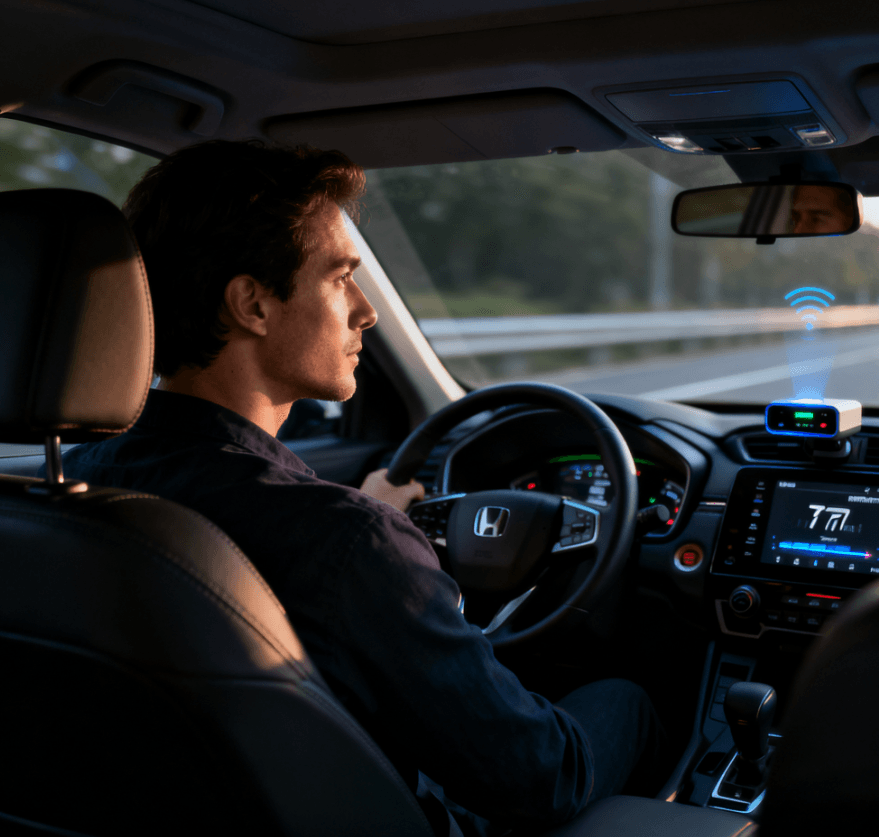In the evolving landscape of intelligent vehicles, ensuring driver safety goes beyond traditional measures like seat belts or lane assistance. Modern vehicles are increasingly equipped with advanced sensors capable of monitoring not only the surrounding environment but also the physiological well-being of drivers in real-time. 77GHz millimeter-wave (mmWave) radar technology has emerged as a key solution, enabling non-invasive detection of vital signs such as heart rate and respiratory rate directly from the driver’s seat.
Why mmWave Radar Is Ideal for In-Vehicle Health Monitoring
Monitoring vital signs in a vehicle presents unique challenges. Conventional approaches often rely on wearable devices, which can be inconvenient or uncomfortable for drivers. mmWave radar offers distinct advantages:
-
Non-Contact Measurement
By detecting subtle chest movements caused by heartbeats and breathing, mmWave radar provides continuous physiological monitoring without the need for wearable devices, ensuring comfort and convenience for the driver. -
Reliable Across Conditions
Radar-based monitoring is largely unaffected by lighting conditions, shadows, or visual obstructions, making it effective both day and night, in tunnels, or under inclement weather. -
High-Precision Micro-Motion Detection
mmWave radar can sense movements on the millimeter scale. This allows highly accurate detection of subtle physiological motions, enabling real-time monitoring of vital signs even in dynamic vehicle environments. -
Privacy-Preserving Monitoring
Unlike cameras, radar sensors detect movement rather than capturing visual images, providing actionable health information while maintaining driver privacy.
Technical Approach to Driver Vital Sign Monitoring
Detecting vital signs using mmWave radar relies on advanced signal processing techniques:
-
Micro-Motion Analysis
Heartbeats and breathing cause chest displacements typically ranging from 0.1 to 2 millimeters. Radar signals capture these micro-movements and convert them into measurable physiological data. -
Signal Filtering and Separation
Raw radar data includes environmental noise and vehicle vibrations. Sophisticated algorithms filter unwanted signals and isolate vital signs with high accuracy. -
Driver-Focused Targeting
Multi-passenger scenarios or moving cabin components can interfere with measurements. Beamforming and multi-antenna radar configurations allow the system to focus specifically on the driver, ensuring reliable readings.
These techniques collectively enable real-time, precise, and non-intrusive vital sign monitoring in vehicles.
Applications in Enhancing Driver Safety
Fatigue and Drowsiness Detection
Driver fatigue is a leading factor in traffic accidents globally. Continuous monitoring of heart rate variability and respiratory patterns can detect early signs of drowsiness. Vehicles equipped with radar-based monitoring can issue timely alerts, adjust cabin conditions, or activate safety mechanisms to mitigate risks.
Medical Emergency Response
Monitoring vital signs non-invasively allows early detection of health anomalies, such as irregular heart rhythms. In semi-autonomous driving scenarios, the system can trigger preventive measures, including reducing speed, alerting the driver, or guiding the vehicle to the nearest medical facility.
Long-Term Health Insights
Beyond immediate safety, continuous monitoring provides insights into driver health trends. Analytics can track long-term patterns, enabling proactive health management while maintaining strict privacy through local data processing and encryption.
Addressing Technical Challenges
Implementing in-vehicle mmWave radar monitoring presents challenges, which can be addressed through careful system design:
-
Environmental Interference
Vehicle vibrations, seat materials, and electronic devices can introduce noise. Multi-channel radar and adaptive filtering improve measurement accuracy. -
Passenger Interference
Other occupants’ movements may confound measurements. Sensor placement and focused beamforming ensure the radar targets only the driver. -
Data Security and Privacy
Vital sign data is sensitive. Systems should include local processing, encryption, and user-controlled data permissions to prevent misuse.
Future Directions
-
Integration with Intelligent Vehicle Systems
Vital sign monitoring could be fully integrated with autonomous or semi-autonomous driving systems, enabling real-time health-based vehicle responses. -
Multi-Sensor Fusion
Combining radar data with other in-cabin sensors—such as pressure, acoustic, or environmental sensors—can enhance detection accuracy and robustness. -
Predictive Health Analytics
Advanced algorithms can analyze longitudinal data to anticipate potential health events, allowing the vehicle to proactively protect the driver.
Conclusion
77GHz mmWave radar represents a significant advancement in automotive safety technology. By enabling non-invasive, real-time monitoring of driver vital signs, vehicles can detect fatigue, drowsiness, and physiological anomalies early, allowing timely intervention. As intelligent vehicle technology progresses, integrating mmWave radar for health monitoring transforms vehicles into proactive partners in driver safety and well-being.
Frequently Asked Questions
Q1: Is a wearable device required?
A1: No, mmWave radar detects vital signs directly from the seat, eliminating the need for wearables.
Q2: Can it operate in low-light conditions?
A2: Yes, radar is unaffected by lighting, shadows, or visual obstructions, ensuring continuous monitoring.
Q3: How is privacy protected?
A3: Radar captures movement rather than images, and all data can be encrypted and processed locally, ensuring privacy.



